Application of Excimer Lamp in Quantitative Detection of SF6 Decomposition Component SO2
Abstract
:1. Introduction
- (1)
- Study of the characteristic of UV excimer lamp and the feasibility of its application in UV absorption spectroscopy;
- (2)
- Establishment of trace SO2 quantitative detection system based on excimer lamp and evaluation of the performance of the presented detection system;
- (3)
- Selection of the most prominent absorption peak among the absorption spectra by calculating spectral derivative for quantitative analysis.
2. Theoretically Fundamental
2.1. Basic Principle of Excimer Lamp
2.2. Basic Principle of Absorption Spectroscopy
3. Experimental Setups
3.1. The Selection of the Formula of Excimer Lamp
3.2. Basic Structure of Detection System
4. Experimental Results and Analysis
4.1. The Influence of Dark Current
4.2. Quantitative Analysis of Trace SO2 Detection
4.3. Estimation of the Detection Performance
- (1)
- Introduce one gas sample into the gas cell for detection;
- (2)
- Detect five successive points of transmission light intensity and calculate their average as the detection transmission light intensity;
- (3)
- Take the detection transmission light intensity to calculate the corresponding concentration. The calculated concentration is then taken as the detection result;
- (4)
- Clean the detection system and repeat above procedure in order to obtain the detection result of each gas sample.
- (1)
- Introduce pure SF6 into the gas cell for detection;
- (2)
- Detect five successive points and calculate their average as the background signal and the standard deviation of their absorbance as the systematic noise;
- (3)
- Clean the detection system and introduce gas samples into the gas cell for detection;
- (4)
- Detect five successive points of transmission light intensity and calculate the average of their absorbance;
- (5)
- Calculate DL.
4.4. Discussion and Future Works
5. Conclusions
Author Contributions
Funding
Institutional Review Board Statement
Informed Consent Statement
Data Availability Statement
Acknowledgments
Conflicts of Interest
References
- Tang, J.; Liu, F.; Meng, Q.; Zhang, X.; Tao, J. Partial discharge recognition through an analysis of SF6 decomposition products part 2: Feature extraction and decision tree-based pattern recognition. IEEE Trans. Dielectr. Electr. Insul. 2012, 19, 37–44. [Google Scholar] [CrossRef]
- Guozhi, Z.; Zhang, G.; Xingrong, H.; Jia, Y.; Tang, J.; Yue, Z.; Yuan, T.; Zhenze, L. On-Line Monitoring of Partial Discharge of Less-Oil Immersed Electric Equipment Based on Pressure and UHF. IEEE Access 2019, 7, 11178–11186. [Google Scholar] [CrossRef]
- N’Cho, J.S.; Fofana, I.; Hadjadj, Y.; Beroual, A. Review of Physicochemical-Based Diagnostic Techniques for Assessing Insulation Condition in Aged Transformers. Energies 2016, 9, 367. [Google Scholar] [CrossRef]
- Yang, J.G.; Shi, W.; Li, H.T.; Gong, B.; Jiang, W.Y. Analysis of partial discharge Ultrasonic wave characteristic on typical Defects in GIS. In MATEC Web of Conferences; EDP Sciences: Les Ulis, France, 2016; Volume 63, p. 1017. [Google Scholar] [CrossRef] [Green Version]
- Lin, T.; Han, D.; Zhang, G.; Liu, D. Influence of trace O2 on SF6 decomposition characteristics under partial discharge based on oxygen isotope tracer. IEEE Trans. Dielectr. Electr. Insul. 2017, 24, 1600–1607. [Google Scholar] [CrossRef]
- Sampaolo, A.; Patimisco, P.; Giglio, M.; Chieco, L.; Scamarcio, G.; Tittel, F.K.; Spagnolo, V. Highly sensitive gas leak detector based on a quartz-enhanced photoacoustic SF6 sensor. Opt. Express 2016, 24, 15872–15881. [Google Scholar] [CrossRef] [Green Version]
- Spagnolo, V.; Patimisco, P.; Borri, S.; Scamarcio, G.; Bernacki, B.E.; Kriesel, J. Part-per-trillion level SF6 detection using a quartz enhanced photoacoustic spectroscopy-based sensor with single-mode fiber-coupled quantum cascade laser excitation. Opt. Lett. 2012, 37, 4461–4463. [Google Scholar] [CrossRef] [PubMed]
- ION, SF6 Leakmate-Portable SF6 Leak Monitor. Available online: https://ionscience.com/en/products/sf6-leakmate-portable-sf6-leak-monitor/ (accessed on 10 November 2021).
- VAISALA, SF6 Gas Insulated Equipment. Available online: https://www.vaisala.com/en/industries-applications/power-industry-applications/sf6-gas-insulated-equipment?utm_medium=cpc&utm_source=google&utm_campaign=VIM-GLO-EN-POW&gclid=EAIaIQobChMIlb2R6pfq8wIV1-h3Ch3_4wWEEAAYAyAAEgKQ0vD_BwE (accessed on 10 November 2021).
- Yin, X.; Dong, L.; Wu, H.; Zhang, L.; Ma, W.; Yin, W.; Xiao, L.; Jia, S.; Tittel, F.K. Highly sensitive photoacoustic multicomponent gas sensor for SF6 decomposition online monitoring. Opt. Express 2019, 27, A224–A234. [Google Scholar] [CrossRef] [Green Version]
- Zhang, X.; Xiao, H.; Li, X.; Zhang, J. Ultraviolet differential spectroscopy quantitative analysis of SF 6 decomposition component SO2. IET Sci. Meas. Technol. 2018, 12, 328–334. [Google Scholar] [CrossRef]
- Yin, X.; Dong, L.; Wu, H.; Zheng, H.; Ma, W.; Zhang, L.; Yin, W.; Xiao, L.; Jia, S.; Tittel, F.K. Highly sensitive SO2 photoacoustic sensor for SF6 decomposition detection using a compact mW-level diode-pumped solid-state laser emitting at 303 nm. Opt. Express 2017, 25, 32581–32590. [Google Scholar] [CrossRef]
- Weng, W.; Aldén, M.; Li, Z. Quantitative SO2 Detection in Combustion Environments Using Broad Band Ultraviolet Absorption and Laser-Induced Fluorescence. Anal. Chem. 2019, 91, 10849–10855. [Google Scholar] [CrossRef] [PubMed] [Green Version]
- Zhang, X.; Liu, H.; Ren, J.; Li, J.; Li, X. Fourier transform infrared spectroscopy quantitative analysis of SF6 partial discharge decomposition components. Spectrochim. Acta Part A Mol. Biomol. Spectrosc. 2015, 136, 884–889. [Google Scholar] [CrossRef]
- Spangenberg, M.; Bryant, J.I.; Gibson, S.J.; Mousley, P.J.; Ramachers, Y.; Bell, G.R. Ultraviolet absorption of contaminants in water. Sci. Rep. 2021, 11, 3682. [Google Scholar] [CrossRef]
- Zhao, J.; Guo, J.; Shi, J.; Yu, Z.; Zhang, H. Ultra-low flue gas emission monitoring based on differential optical absorption spectroscopy. Int. Soc. Opt. Photonics 2019, 11189, 111891E. [Google Scholar] [CrossRef]
- Zhang, H.J.; Han, Q.Y.; Zhang, S.D. 254 nm Radiant Efficiency of High Output Low Pressure Mercury Discharge Lamps with Neon-Argon Buffer Gas. Appl. Mech. Mater. 2013, 325-326, 409–412. [Google Scholar] [CrossRef]
- Kogelschatz, U.; Eliasson, B.; Esrom, H. Industrial applications of excimer ultraviolet sources. Mater. Des. 1991, 12, 251–258. [Google Scholar] [CrossRef]
- Eliasson, B.; Kogelschatz, U. Modeling and applications of silent discharge plasmas. IEEE Trans. Plasma Sci. 1991, 19, 309–323. [Google Scholar] [CrossRef]
- Zou, J.; Wang, F. Simultaneous measurement of SO2 and NO2 concentration using an optical fiber-based LP-DOAS system. Chin. Opt. Lett. 2020, 18, 021201. [Google Scholar] [CrossRef]
- Gordon, I.E.; Rothman, L.S.; Hill, C.; Kochanov, R.V.; Tan, Y.; Bernath, P.F.; Birk, M.; Boudon, V.; Campargue, A.; Chance, K.V.; et al. The HITRAN2016 molecular spectroscopic database. J. Quant. Spectrosc. Radiat. Transf. 2017, 203, 3–69. [Google Scholar] [CrossRef]
- Blackie, D.; Blackwell-Whitehead, R.; Stark, G.; Pickering, J.C.; Smith, P.L.; Rufus, J.; Thorne, A.P. Correction to “High-resolution photoabsorption cross-section measurements of SO2 at 198 K from 213 to 325 nm”. J. Geophys. Res. Space Phys. 2011, 116, E12099. [Google Scholar] [CrossRef]
- Yin, X.; Wu, H.; Dong, L.; Li, B.; Ma, W.; Zhang, L.; Yin, W.; Xiao, L.; Jia, S.; Tittel, F.K. ppb-Level SO2 Photoacoustic Sensors with a Suppressed Absorption–Desorption Effect by Using a 7.41 μm External-Cavity Quantum Cascade Laser. ACS Sens. 2020, 5, 549–556. [Google Scholar] [CrossRef]
- Chen, T.; Ma, F.; Zhao, Y.; Liao, Z.; Qiu, Z.; Zhang, G. Cantilever enhanced based photoacoustic detection of SF6 decomposition component SO2 using UV LED. Sens. Rev. 2021. ahead-of-print. [Google Scholar] [CrossRef]
- Zhang, J.; Boyd, I.W. Efficient excimer ultraviolet sources from a dielectric barrier discharge in rare-gas/halogen mixtures. J. Appl. Phys. 1996, 80, 633–638. [Google Scholar] [CrossRef]
- Zhang, G.; Hao, H.; Wang, Y.; Jiang, Y.; Shi, J.; Yu, J.; Cui, X.; Li, J.; Zhou, S.; Yu, B. Optimized adaptive Savitzky-Golay filtering algorithm based on deep learning network for absorption spectroscopy. Spectrochim. Acta Part A Mol. Biomol. Spectrosc. 2021, 263, 120187. [Google Scholar] [CrossRef]
- Fonsen, J.; Koskinen, V.; Roth, K.; Kauppinen, J. Dual cantilever enhanced photoacoustic detector with pulsed broadband IR-source. Vib. Spectrosc. 2009, 50, 214–217. [Google Scholar] [CrossRef]
- Zhang, X.; Zhang, Y.; Tang, J.; Cui, Z.; Li, Y.; Zhou, H.; Zhang, G.; Yang, J. Optical technology for detecting the decomposition products of SF6: A review. Opt. Eng. 2018, 57, 110901. [Google Scholar] [CrossRef]

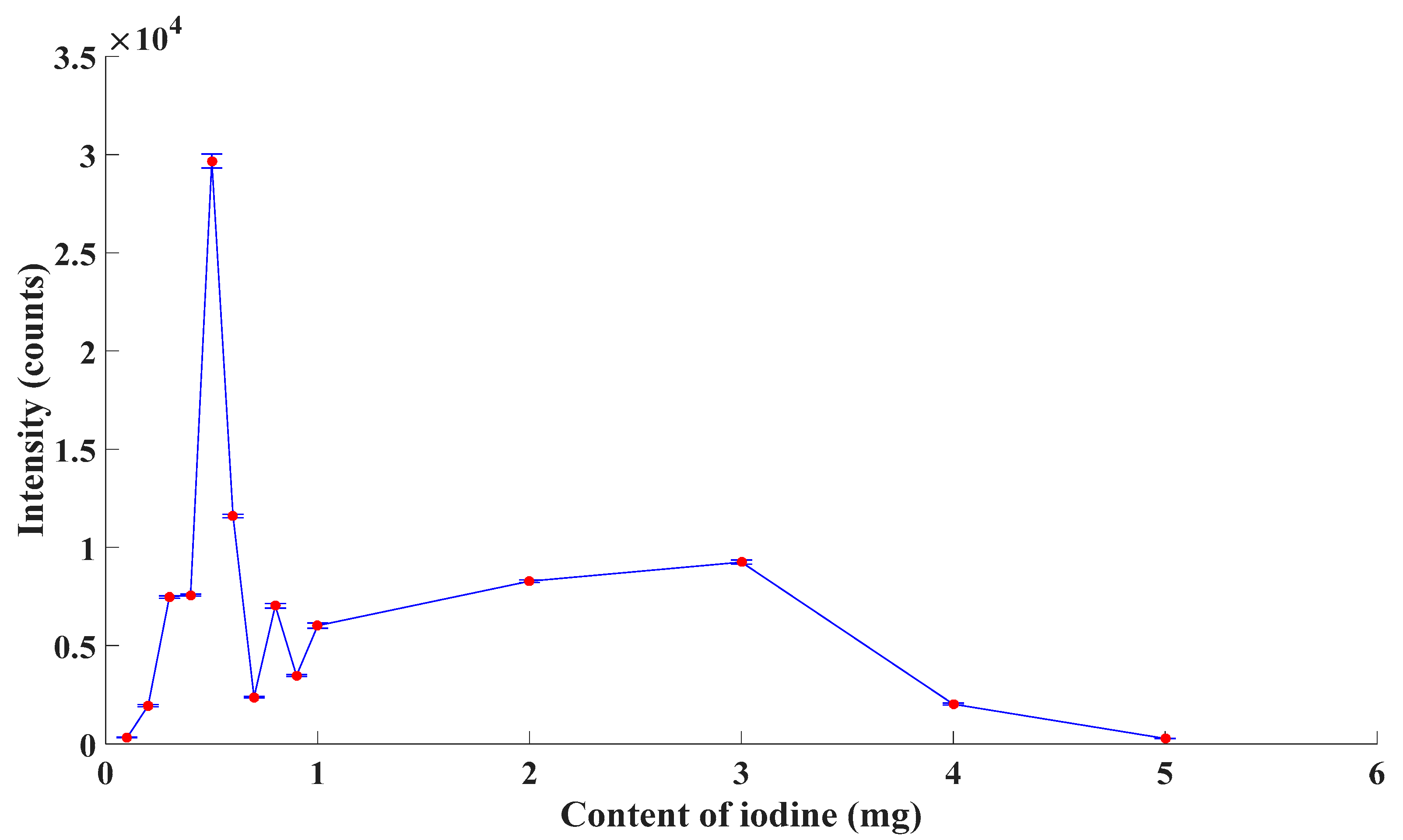

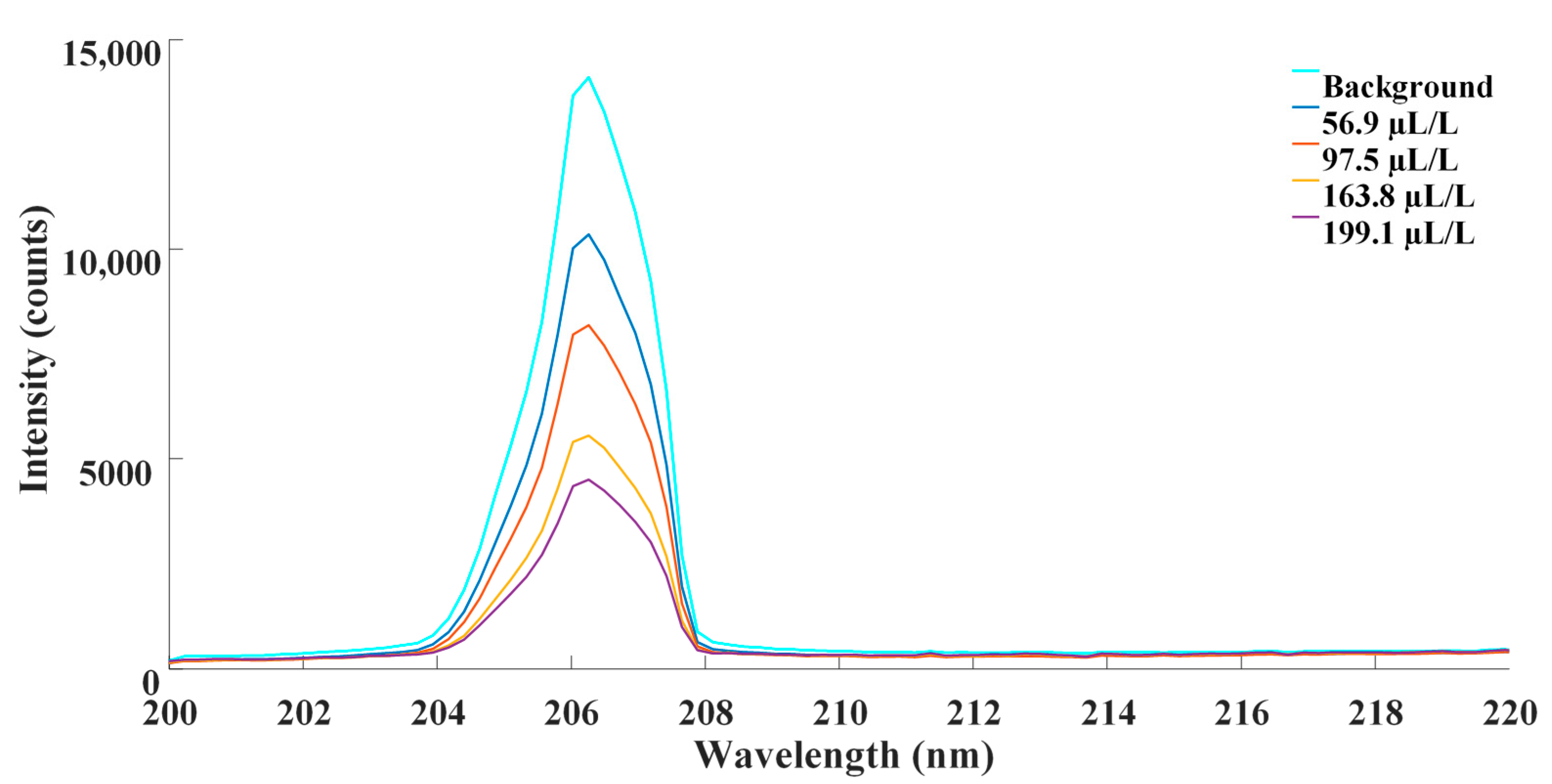
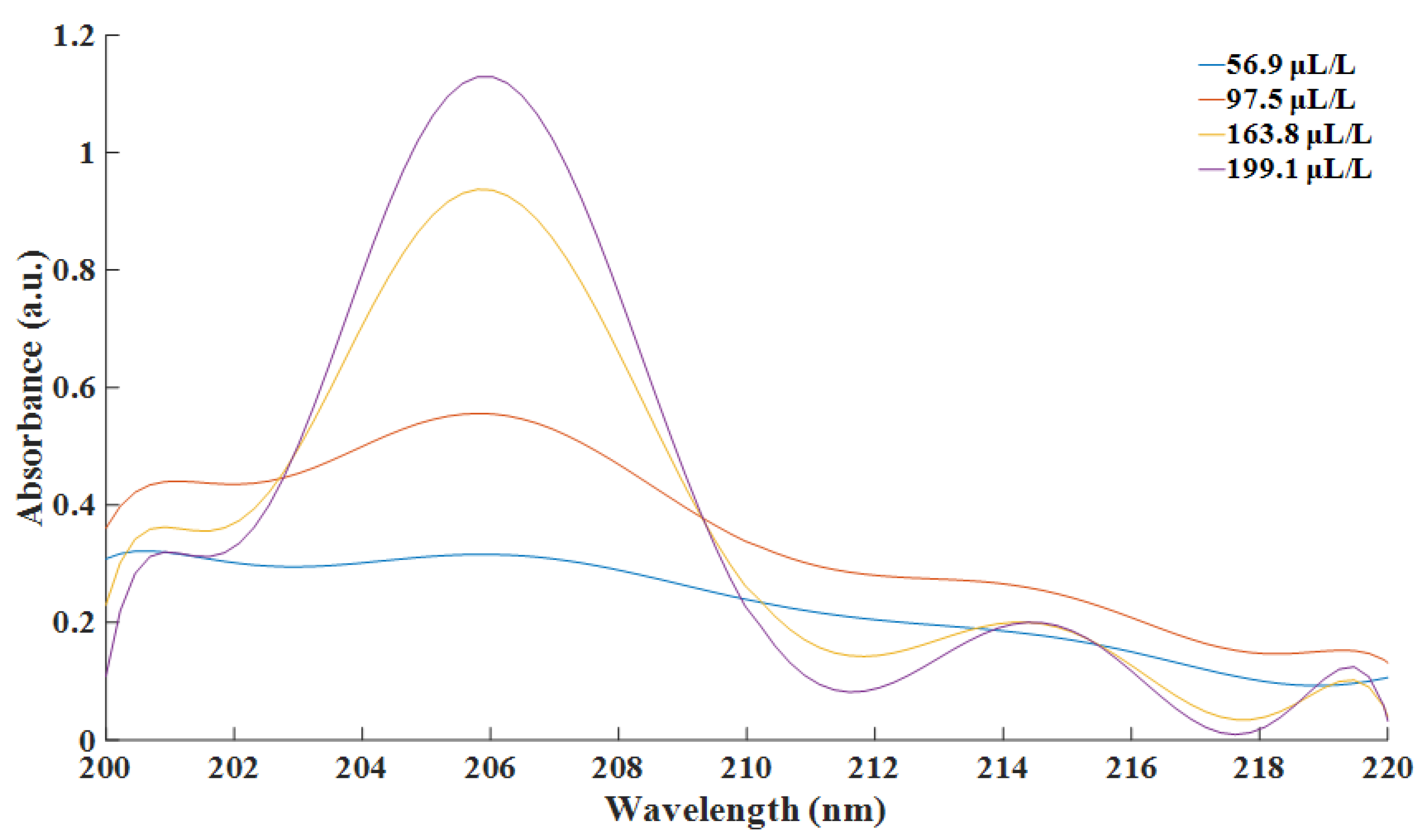

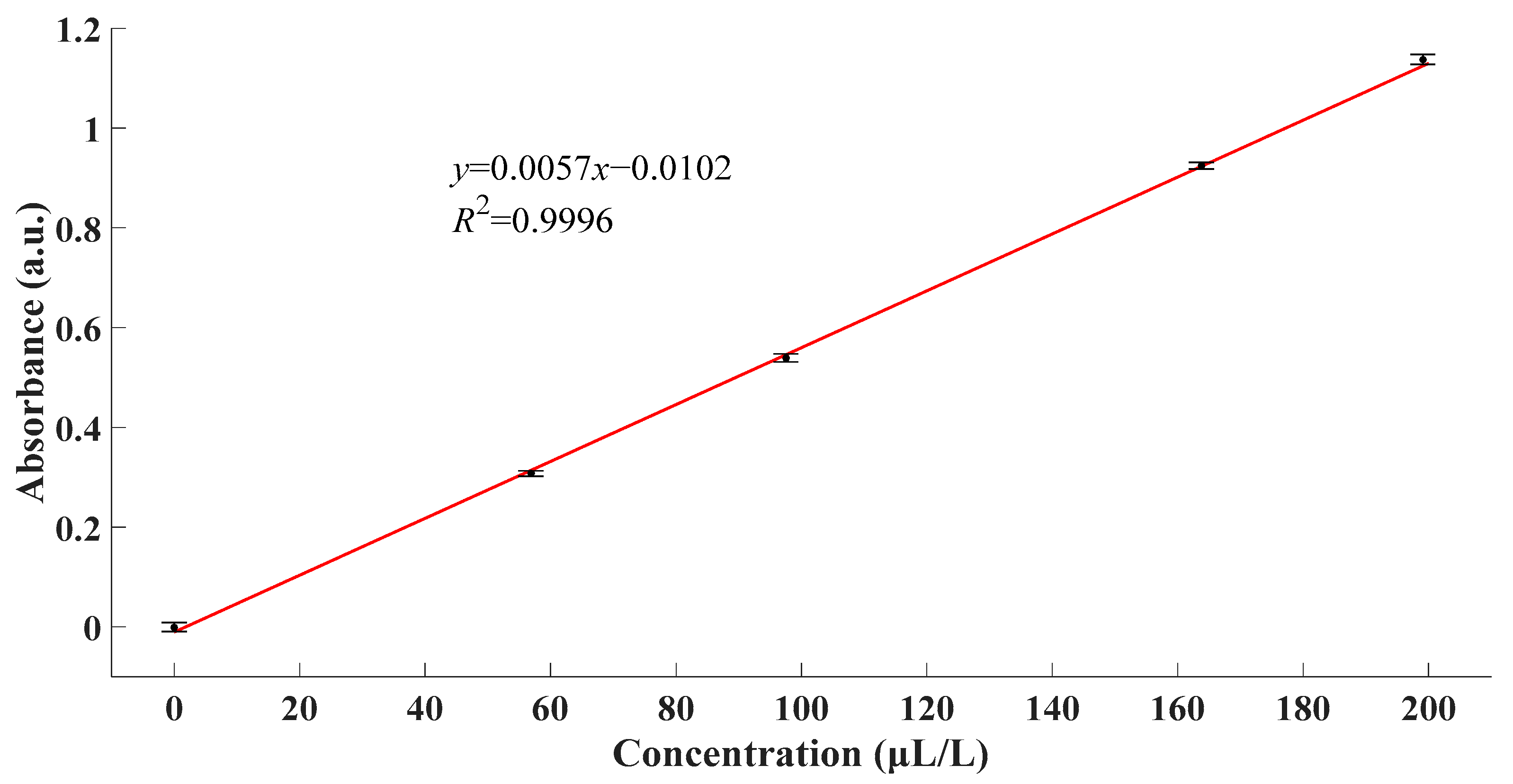
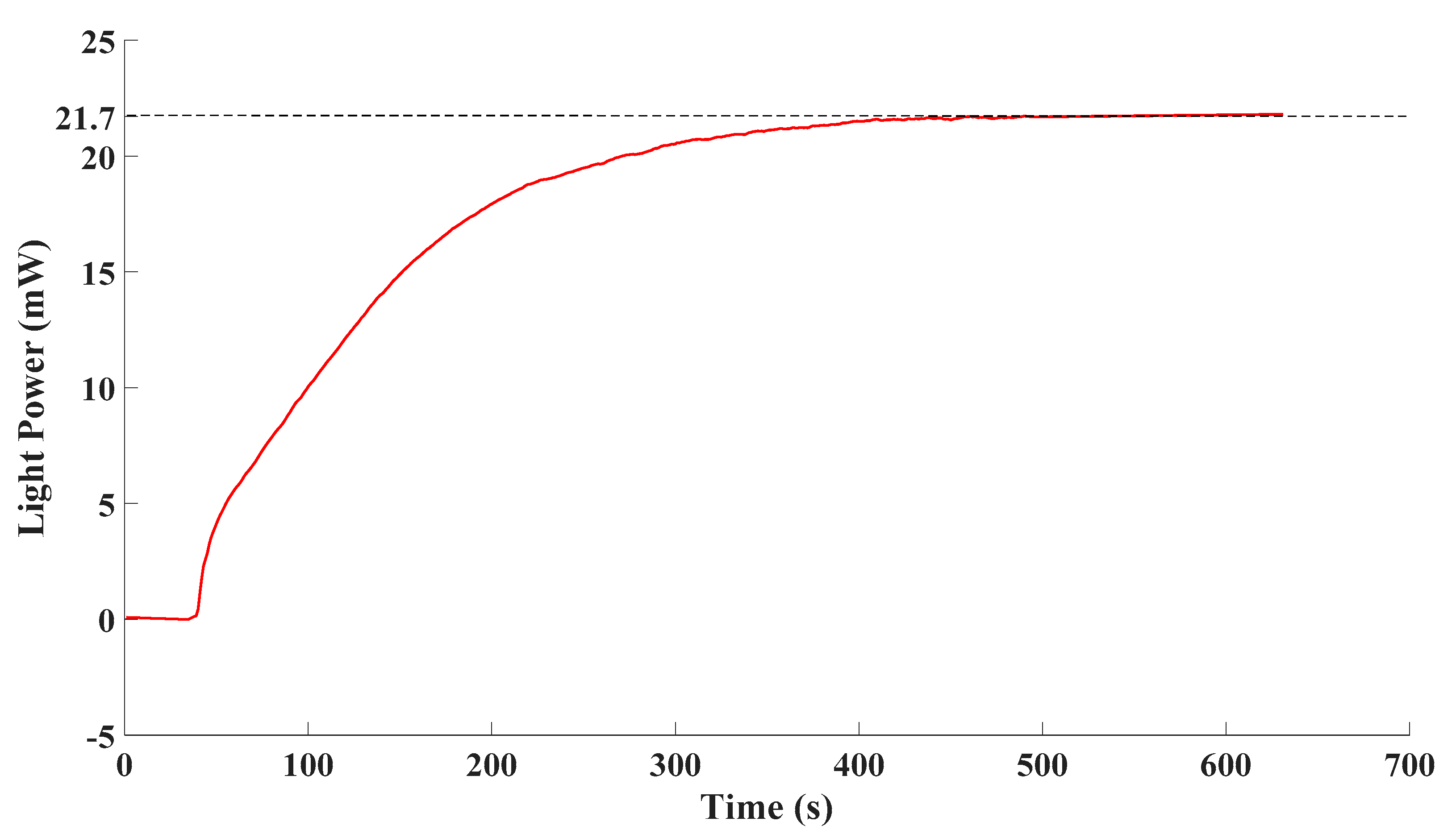
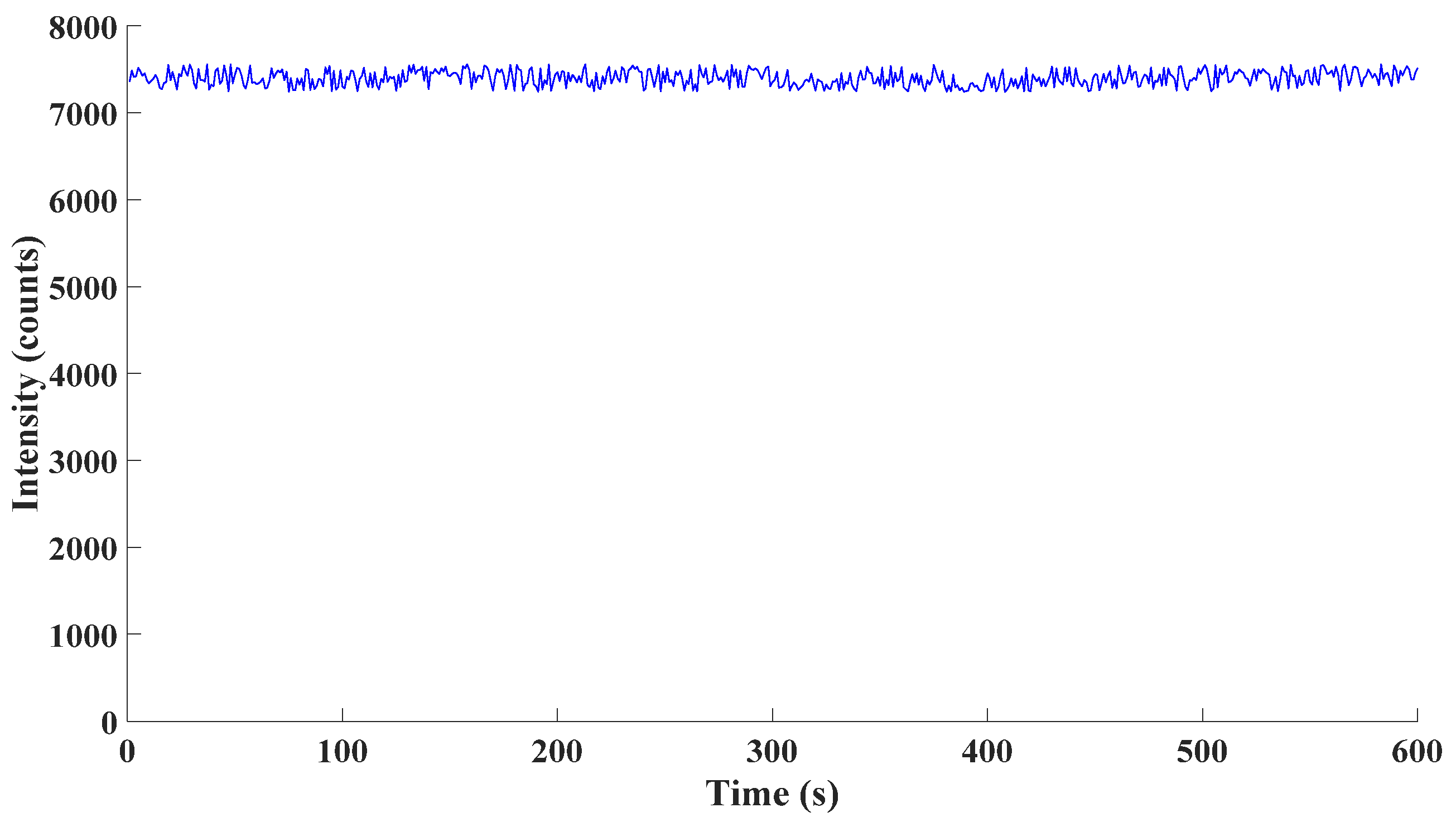
| Formula | Nominal Wavelength |
|---|---|
| F-Kr | 220 nm, 248 nm, 272 nm, 275 nm |
| Cl-Kr | 200 nm, 222 nm, 240 nm, 235 nm |
| Br-Kr | 207 nm, 222 nm, 228 nm |
| I-Kr | 190 nm, 195 nm, 206 nm, 225 nm |
| Gas Sample | Detection Result (μL/L) | Gas Concentration (μL/L) | Relative Error (%) |
|---|---|---|---|
| 1 | 3.9 (±23.189%) | 3.3 (±2.255%) | 18.1 |
| 2 | 6.2 (±20.239%) | 6.4 (±2.255%) | 3.1 |
| 3 | 15.5 (±7.026%) | 15.8 (±2.255%) | 1.9 |
| 4 | 84.6 (±2.023%) | 83.5 (±2.255%) | 1.3 |
| 5 | 126.3 (±1.857%) | 116.9 (±2.255%) | 8.0 |
| 6 | 139.5 (±3.393%) | 135.6 (±2.255%) | 2.9 |
| Signal of Gas Sample | Systematic Noise | Signal to Noise Ratio | Detection Limit |
|---|---|---|---|
| 0.310 | 3.47 × 10−3 | 90.038 | 0.632 μL/L |
| Methods | Detection Limit | Response Speed |
|---|---|---|
| UV-DOAS | Sub-ppm | Fast |
| UV fluorescence | Sub-ppm | Fast |
| FTIR | ppm | Medium |
| PAS | Sub-ppm | Fast |
| Proposed detection system | Sub-ppm | Fast |
Publisher’s Note: MDPI stays neutral with regard to jurisdictional claims in published maps and institutional affiliations. |
© 2021 by the authors. Licensee MDPI, Basel, Switzerland. This article is an open access article distributed under the terms and conditions of the Creative Commons Attribution (CC BY) license (https://creativecommons.org/licenses/by/4.0/).
Share and Cite
Chen, T.; Li, K.; Ma, F.; Qiu, X.; Qiu, Z.; Liao, Z.; Zhang, G. Application of Excimer Lamp in Quantitative Detection of SF6 Decomposition Component SO2. Sensors 2021, 21, 8165. https://doi.org/10.3390/s21248165
Chen T, Li K, Ma F, Qiu X, Qiu Z, Liao Z, Zhang G. Application of Excimer Lamp in Quantitative Detection of SF6 Decomposition Component SO2. Sensors. 2021; 21(24):8165. https://doi.org/10.3390/s21248165
Chicago/Turabian StyleChen, Tunan, Kang Li, Fengxiang Ma, Xinjie Qiu, Zongjia Qiu, Zhenghai Liao, and Guoqiang Zhang. 2021. "Application of Excimer Lamp in Quantitative Detection of SF6 Decomposition Component SO2" Sensors 21, no. 24: 8165. https://doi.org/10.3390/s21248165
APA StyleChen, T., Li, K., Ma, F., Qiu, X., Qiu, Z., Liao, Z., & Zhang, G. (2021). Application of Excimer Lamp in Quantitative Detection of SF6 Decomposition Component SO2. Sensors, 21(24), 8165. https://doi.org/10.3390/s21248165






